"Fools rush in where angels fear to tread", thus with this warning, I must confess my total ignorance and I am carefully venturing into an area that I know very little about and I haven't been able to find any written information. Therefore, if any surfers know more about this subject click the "inform me link" on the bottom of this page.
The custom of giving an apostle spoon to a newborn child was documented in the 1500's and there is a link to the Apostle spoon exhibit at the bottom of this page. Apostle spoon have been fairly well researched and there are books showing a tremendous variety of these spoons.
I do not know much about religious baptism customs, but I believe that these spoons were used in these customs or in other religious ceremonies, although I have no idea as to which religions or sects used these pieces.
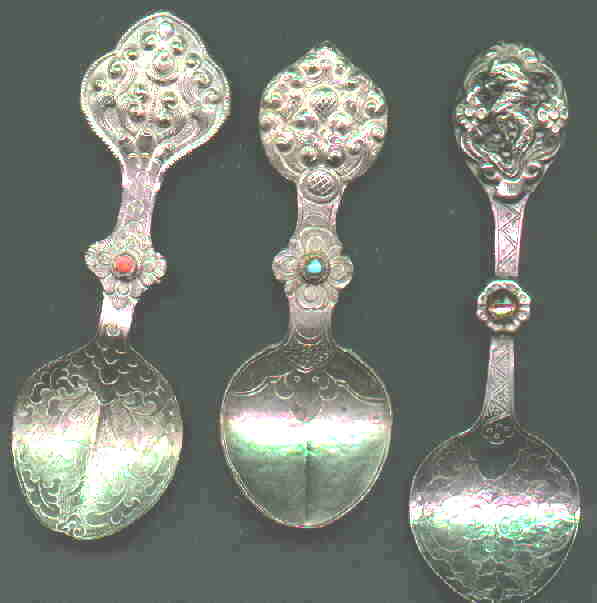
These spoons are all hand made, and while they are very similar in style, they also show many obvious differences.
The center stones are usually coral or turquoise (coral color and blue). The rightmost spoon, however, is a faceted purple glass.
The bowls all have a hump in the middle dividing them in half and in that respect are similar to annointing spoons which were used on the British Monarchy. It is this hump which leads me to believe that they are baptism spoons.
There are no identifying marks of any kind, but I believe that they are basically silver. The total lack of marks may indicate a non-European heritage, but if they were made for "church use", marking requirements may have been waived.
I cannot say for sure where they are from. Discussions with several "experts" have leaned toward Russian or Russian-Asian area, but others have suggested South America, Africa, Balkans, etc. The third spoon has a dragon finial (detail below). This leads me to suspect that perhaps they are Chinese, since the Chinese revered the dragon as part of the yin/yang of life, but many other cultures also used dragon symbols.
Rainwater has indicated that she thinks the spoons are from Tibet and were for ceremonial purposes. She says that the spoons were purchased in India from Tibetans who said that they were selling personal possessions. I cannot question her veracity, but I do question this hypothesis.
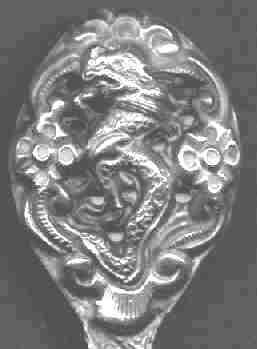
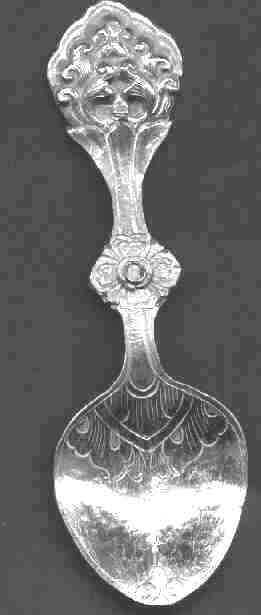 Another
example with turquoise
Another
example with turquoise

This very finely chased and engraved spoon with a hand cutout cross finial also has the raised hump in the middle. Unfortunately the marks are an imitation of the English style of marking, but they are NOT English. English pseudo marks were commonly used in British colonies including the USA in the eighteenth and early part of the nineteenth century. You can use the bar at the bottom of the screen so you can see the finial
On most of the other pages, I provided the basic information. Now surfers, I need help.

This stork spoon was used as a "birth" spoon. There are many different stork variations available. Some of them are engraved in the bowl with names, dates, weights etc.


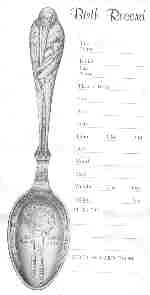
This Reed and Barton stork spoon is new and still in the original box. It comes with a form which the purchaser is supposed to fill out and then mail to the company along with the spoon. They will then engrave the information into the spoon bowl and return it. I can't tell how old this spoon is, but the box looks like fairly modern construction and the spoon is in a plastic bag. The sample on the form has a 1939 date engraved on it. I suspect that the company has had this spoon available for a great many years, but since not too many follow this custom any more, the spoons are still fairly rare.

Virtually any spoon could be used as a birth spoon, and many were.
The "CE" finial stands for "Christian Endeavors"
This one is of interest to me primarily because it has my birth date (except for the year) engraved in the bowl.
There is a little band wrapped around the handle. It says "For Christ and the Church"

This spoon showing a baby face "emerging from an egg" is often engraved with a childs name
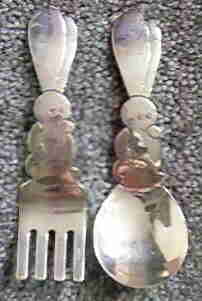
This cute "art deco" style snowman set is by Allan Adler, Los Angeles. It was probably a present to a newborn.
A large variety of spoons dedicated as infant feeders are also available. Most are silver plated although some older ones are sterling and new ones are plastic.
click to see apostle spoons
click to see dragon spoons
click to see Dutch Funeral spoons
click to see Norwegian Coronation spoons which may have been used as baptism spoons